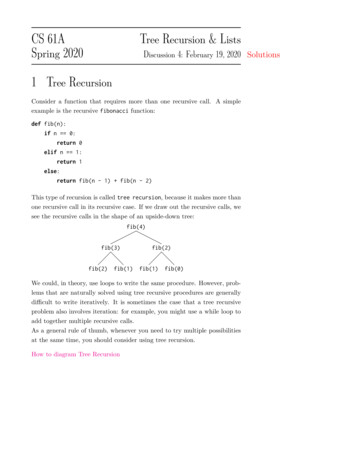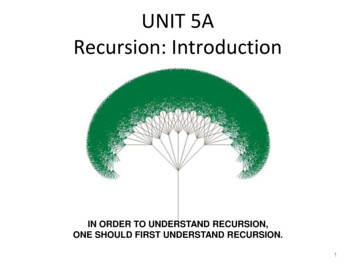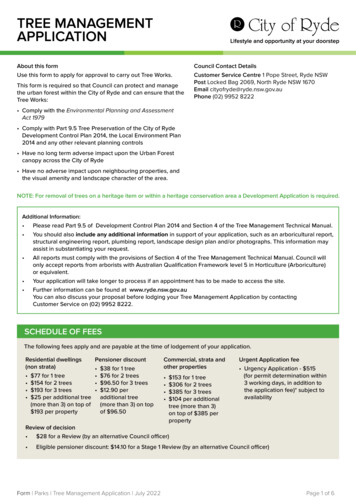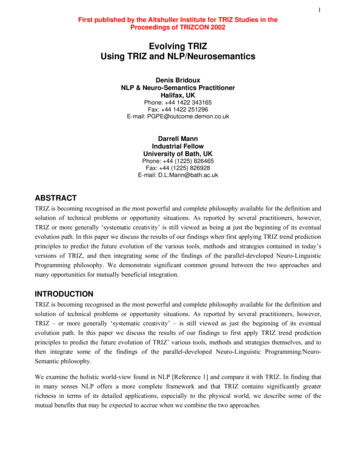
Transcription
CS 61ASpring 20201Tree Recursion & ListsDiscussion 4: February 19, 2020 SolutionsTree RecursionConsider a function that requires more than one recursive call. A simpleexample is the recursive fibonacci function:def fib(n):if n 0:return 0elif n 1:return 1else:return fib(n - 1) fib(n - 2)This type of recursion is called tree recursion, because it makes more thanone recursive call in its recursive case. If we draw out the recursive calls, wesee the recursive calls in the shape of an upside-down tree:fib(4)fib(3)fib(2)fib(2) fib(1)fib(1) fib(0)We could, in theory, use loops to write the same procedure. However, problems that are naturally solved using tree recursive procedures are generallydifficult to write iteratively. It is sometimes the case that a tree recursiveproblem also involves iteration: for example, you might use a while loop toadd together multiple recursive calls.As a general rule of thumb, whenever you need to try multiple possibilitiesat the same time, you should consider using tree recursion.How to diagram Tree Recursion
2Tree Recursion & ListsQuestions1.1You want to go up a flight of stairs that has n steps. You can either take 1or 2 steps each time. How many different ways can you go up this flight ofstairs? Write a function count stair ways that solves this problem. Assumen is positive.Before we start, what’s the base case for this question? What is the simplestinput?When there is only 1 step, there is only one way to go up the stair. Whenthere are two steps, we can go up in two ways: take a two-step, or take 2one-steps.What do count stair ways(n - 1) and count stair ways(n - 2) represent?count stair ways(n - 1) represents the number of different ways to go upthe last n 1 stairs (this is the case where we take 1 step as our move).count stair ways(n - 2) represents the number of different ways to go upthe last n 2 stairs (this is the case where we take 2 steps as our move).Our base cases will take care of the remaining 1 or 2 steps.Fill in the code for count stair ways:def count stair ways(n):if n 0return 1elif n 1:return 1return count stair ways(n-1) count stair ways(n-2)Video walkthrough (Leap of Faith)Video Walkthrough (Diagramming Trees)Note: This worksheet is a problem bank—most TAs will not cover all the problems in discussion section.
Tree Recursion & Lists1.23Consider a special version of the count stairways problem, where insteadof taking 1 or 2 steps, we are able to take up to and including k steps ata time.Write a function count k that figures out the number of paths for this scenario. Assume n and k are positive.def count k(n, k):""" count k(3, 3) # 3, 2 1, 1 2, 1 1 14 count k(4, 4)8 count k(10, 3)274 count k(300, 1) # Only one step at a time1"""if n 0:return 1elif n 0:return 0else:total 0i 1while i k:total count k(n - i, k)i 1return totalVideo WalkthroughNote: This worksheet is a problem bank—most TAs will not cover all the problems in discussion section.
42Tree Recursion & ListsListsA sequence is an ordered collection of values. It has two fundamental properties: length and element selection. In this discussion, we’ll explore one ofPython’s data types, the list, which implements this abstraction.In Python, we can have lists of whatever values we want, be it numbers,strings, functions, or even other lists! Furthermore, the types of the list’scontents need not be the same. In other words, the list need not be homogenous.Lists can be created using square braces. Their elements can be accessed(or indexed ) with square braces. Lists are zero-indexed: to access the firstelement, we must index at 0; to access the ith element, we must index ati 1.We can also index with negative numbers. These begin indexing at the endof the list, so the index 1 is equivalent to the index len(list) - 1 andindex 2 is the same as len(list) - 2.Let’s try out some indexing: fantasy team ['aaron rodgers', 'desean jackson'] print(fantasy team)['aaron rodgers', 'desean jackson'] fantasy team[0]'aaron rodgers' fantasy team[len(fantasy team) - 1]'desean jackson' fantasy team[-1]'desean jackson'List SlicingIf we want to access more than one element of a list at a time, we can usea slice. Slicing a sequence is very similar to indexing. We specify a startingindex and an ending index, separated by a colon. Python creates a newlist with the elements from the starting index up to (but not including) theending index.We can also specify a step size, which tells Python how to collect values forus. For example, if we set step size to 2, the returned list will include everyother value, from the starting index until the ending index. A negative stepsize indicates that we are stepping backwards through a list when collectingvalues.Note: This worksheet is a problem bank—most TAs will not cover all the problems in discussion section.
Tree Recursion & Lists5You can also choose not to specify any/all of the slice arguments. Pythonwill perform some default behaviour if this is the case: If the step size is left out, the default step size is 1. If the start index is left out, the default start index is the beginning ofthe list. If the end index is left out, the default end index is the end of the list. If the step size is negative, the default start index becomes the end ofthe list, and the default end index becomes the beginning of the list.Thus, lst[:] creates a list that is identical to lst (a copy of lst). lst[::-1]creates a list that has the same elements of lst, but reversed. Those rulesstill apply if more than just the step size is specified e.g. lst[3::-1]. directors ['jenkins', 'spielberg', 'bigelow', 'kubrick'] directors[:2]['jenkins', 'spielberg'] directors[1:3]['spielberg', 'bigelow'] directors[1:]['spielberg', 'bigelow', 'kubrick'] directors[0:4:2]['jenkins', 'bigelow'] directors[::-1]['kubrick', 'bigelow', 'spielberg', 'jenkins']List ComprehensionsA list comprehension is a compact way to create a list whose elements arethe results of applying a fixed expression to elements in another sequence.[ map exp for name in iter exp if filter exp ]It might be helpful to note that we can rewrite a list comprehension as anequivalent for statement. See the example to the right.Let’s break down an example:[x * x - 3 for x in [1, 2, 3, 4, 5] if x % 2 1]In this list comprehension, we are creating a new list after performing aseries of operations to our initial sequence [1, 2, 3, 4, 5]. We only keepthe elements that satisfy the filter expression x % 2 1 (1, 3, and 5). Foreach retained element, we apply the map expression x*x - 3 before addingit to the new list that we are creating, resulting in the output [-2, 6, 22].Note: This worksheet is a problem bank—most TAs will not cover all the problems in discussion section.
6Tree Recursion & ListsNote: The if clause in a list comprehension is optional.Questions2.1What would Python display? a [1, 5, 4, [2, 3], 3] print(a[0], a[-1])1 3 len(a)5 2 in aFalse 4 in aTrue a[3][0]2Video walkthrough2.2Write a function that takes a list s and returns a new list that keeps onlythe even-indexed elements of s and multiplies them by their correspondingindex.def even weighted(s):""" x [1, 2, 3, 4, 5, 6] even weighted(x)[0, 6, 20]"""return [ ]return [i * s[i] for i in range(len(s)) if i % 2 0]The key point to note is that instead of iterating over each element in thelist, we must instead iterate over the indices of the list. Otherwise, there’sno way to tell if we should keep a given element.Note: This worksheet is a problem bank—most TAs will not cover all the problems in discussion section.
Tree Recursion & Lists7One way of solving these problems is to try and write your solution as afor loop first, and then transform it into a list comprehension. The for loopsolution might look something like this:result []for i in range(len(s)):if i % 2 0:result result [i * s[i]]return resultVideo walkthroughNote: This worksheet is a problem bank—most TAs will not cover all the problems in discussion section.
82.3Tree Recursion & ListsWrite a function that takes in a list and returns the maximum product thatcan be formed using nonconsecutive elements of the list. The input list willcontain only numbers greater than or equal to 1.def max product(s):"""Return the maximum product that can be formed using non-consecutiveelements of s. max product([10,3,1,9,2]) # 10 * 990 max product([5,10,5,10,5]) # 5 * 5 * 5125 max product([])1"""if s []:return 1elif len(s) 1: # Base case optionalreturn s[0]else:return max(max product(s[1:]), s[0] * max product(s[2:]))At each step, we choose if we want to include the current number in ourproduct or not: If we include the current number, we cannot use the adjacent number. If we don’t use the current number, we try the adjacent number (andobviously ignore the current number).The recursive calls represent these two alternate realities. Finally, we pickthe one that gives us the largest product.Video walkthroughNote: This worksheet is a problem bank—most TAs will not cover all the problems in discussion section.
11. Whole Numbers(a) A hole number is a number in which every other digit dips below the digits immediately adjacent to it.For example, the number 968 would be considered a hole number because the number 6 is smaller thanboth of its surrounding digits. Other hole numbers include 9192959 or 324364989. The number 544 wouldnot be considered a hole number. For simplicity assume that we only pass in numbers that have an oddnumber of digits. Define the following function so that it properly identifies hole numbers.def check hole number(n):""" check hole number(123)False check hole number(3241968)True check hole number(3245968)False"""if n // 10 0:return True# The \ symbol just allows me to continue this line of code on a new line.# It's only included to make sure all the code stays on the pagereturn ((n // 10) % 10) (n % 10) and ((n // 10) % 10) ((n // 100) % 10) \and check hole number(n // 100)(b) A mountain number is a number in which the digits from right to left increase toward the middle of thenumber (not necessarily the exact middle digit). After the maximum digit has been reached, the digits tothe left of that maximum digit should strictly decrease. Define the following function so that it properlyidentifies mountain numbersdef check mountain number(n):""" check mountain number(103)False check mountain number(153)True check mountain number(3241968)False check mountain number(2345986)True"""def helper(x, is increasing):if x // 10 0:return Trueif is increasing and (x % 10) ((x // 10) % 10):
2return helper(x // 10, is increasing)return (x % 10) ((x // 10) % 10) and helper(x // 10, False)return helper(n, True)
Tree Recursion & Lists 3 1.2 Consider a special version of the count_stairways problem, where instead of taking 1 or 2 steps, we are able to take up to and including k steps at a time. Write a function count_k that gures out the number of paths for this sce-










